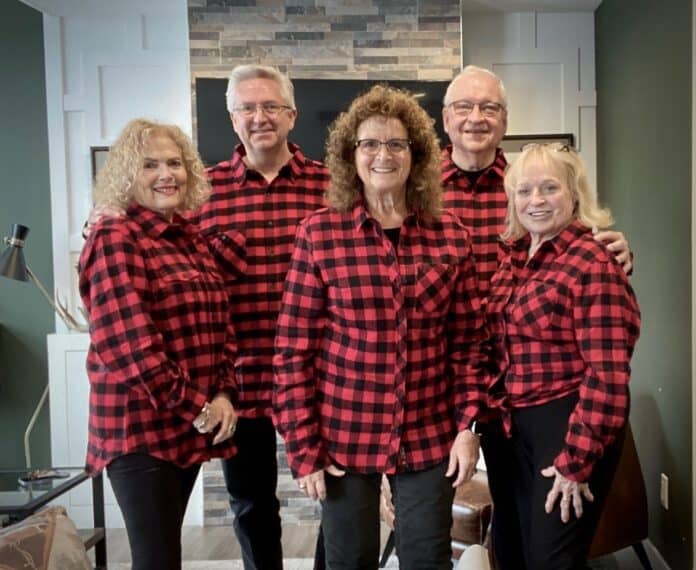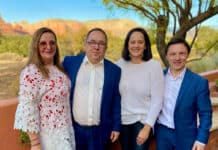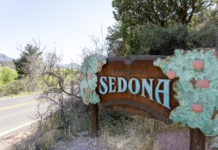
The Sedona Sister Cities Association’s search for a twin city continues. Canmore, Alberta, Canada, is currently at the top of the list of prospects.
Canmore Mayor Sean Krausert will be traveling to Sedona to meet with city officials and residents as well as touring the arts center and film festival.
“I am looking forward to visiting Sedona at the end of April as we continue to explore a sister-city relationship between Canmore and Sedona,” Krausert said in a recent email. “Our communities have a lot in common: Tourist-based economy, rising house prices, staffing issues, a love of nature and art, limited growth boundaries. I’m excited to meet with the mayor of Sedona and all my new Sedona friends as we discuss the path forward.”
Canmore is interested in working with towns looking to explore best practices for sustainable tourism, climate change and transportation and balancing high housing costs in a limited growth area, according to the community pairing survey Canmore officials completed with the Sedona selection committee.
The selection committee started its search with a global list of 45 potential cities last June. In late 2022, the group reported its selection of Canada’s Banff and Ireland’s Lahinch as the finalists. However, Sedona Sister Cities Association Chairman Chuck Marr said that at that point the selection committee hadn’t directly talked to the other cities and their selections were based on research only.
Banff
In November, several members of the selection committee went on an exploratory trip to the Banff Mountain Film Festival. The group learned that because Banff is within a national park, it is governed by both local ordinances and federal regulations, which made it incompatible with Sedona because most of the city’s procedures couldn’t carry over.
“As we talked to people there, they said you really need to talk to people in Canmore, and that’s a town 10 miles south of Banff, [its population is] 16,000. But it’s where almost all the white-collar workers in Banff live,” Marr said.
The selection committee followed the suggestion with an introductory phone call to Canmore Mayor Sean Krausert, who was receptive to the idea and reached out to residents about the proposition.
This led to a Zoom call on Feb. 9 between the selection committee and Canmore’s town leadership in which the participants discussed the shared issues affecting both cities, particularly the act of balancing natural landscapes with the consequences of tourism.
Following the successful Zoom conference, Krausert scheduled a visit to Sedona during the Sedona International Film Festival but had to cancel the trip due to a family emergency.
He will be in Sedona from Friday, April 28, through Saturday, April 29. The major focus of Krausert’s visit will be a meet-and-greet at Sedona City Hall at 9 a.m. on April 29, which will be followed by a private lunch between Krausert and Sedona Mayor Scott Jablow to discuss next steps in the sister city process.
The selection committee’s primary concern is ensuring that Canmore forms a similar group of volunteers to ensure the continuity of the program apart from city bureaucracies and to help coordinate communications between the towns.
“Based on my experience in Omaha [Neb.], these arrangements are only successful if they have a group of dedicated volunteers to continually build the relationship between cities,” Marr said. “City governments turn over but dedicated volunteers remain.”
Canmore doesn’t currently have a formal volunteer group for a sister city partnership,
town spokeswoman Sara Jones explained. Jones elaborated that Canmore’s goal was to have a steering committee work with Sedona to “expand the network of connections” which is still in an early stage of development.
Lahinch
Lahinch was the other finalist to emerge from the committee’s selection process, and the sister city process differs in Ireland. The Irish refer to it as “twinning” and it requires approval from both the city and the county governments.
“We received a thoughtful response from the County Clare Twinning Committee that due to the aftereffects of the pandemic, Lahinch in N.W. County Clare isn’t able to ‘twin’ with Sedona at this time,” the Sedona Sister Cities Association’s March newsletter informed readers.
Two small groups will be traveling to Ireland this summer to investigate two other possible partners. Marr said it was too early in the process to discuss those locations further.
Marr has found the sister city process to be rewarding ever since seeing the effects of cultural exchanges between Omaha [where he previously lived] and one of its sister cities, Shizuoka, Japan. Those cities have been partnered now for over 50 years and provide a case study of the concept.
“The first sister city relationship in Japan was established in December of 1955 between Nagasaki City and St. Paul, Minnesota in the United States,” the Council of Local Authorities for International Relations states on their website. “The number of relationships has increased steadily over the years, reaching 1,000 in December of 1993, and currently exceeds 1,700. The United States is the country with the most sister city relationships with Japan, comprising [sic] around thirty percent of all of Japan’s sister city relationships.”
Sister city programs came into existence after the end of World War II. “President Dwight Eisenhower looked at the world and thought we’ve gone through world wars and the only way we’re going to get through is if you have people meeting people and building relationships town to town,” Marr said.
Eisenhower laid out the vision and values for what would become the sister city model on September 11, 1956, at the White House Conference on Citizen Diplomacy.
“I have been around a long time and therefore more or less acquainted with all of the wars the United States has fought,” Eisenhower said at the conference. “To the glory of American businessmen, I have never heard one single one — ever — refer to war in any terms except those of regret and hope that war will never occur again.”
The selection committee’s trips are self-funded by the members and are driven by the group’s desire to be independent; most of the group’s expenses as a 501(c)(3) nonprofit are for insurance and printing costs.
The timeline for officially becoming sister cities will depend on the outcome of Krausert’s visit and the creation of a Canmore volunteer group. Potential formal exchanges between Sedona and Canmore could take place over the summer, with the groups taking the proposal to their respective city councils for ratification in the fall. Marr added that even if Canmore is selected, Sedona will have the potential to form ties with additional sister cities in the future.
“This is a slow process. It’s meant to be one that builds relationships and understanding over time,” Marr said. “It’s amazing the amount that we can learn from each other. [Sedona] is a terrific community, because there’s such a fascinating mix of people here. Each day I meet a new person with a different background … and the sister cities program is a way to open Sedona to the world.”




















